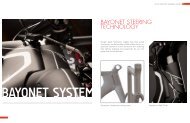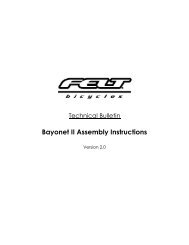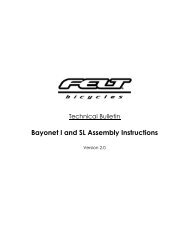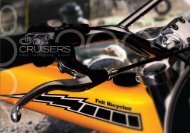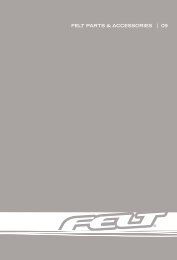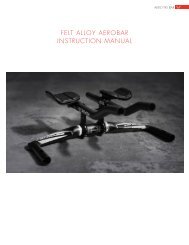Bicycle Owners Manual - Felt Bicycles
Bicycle Owners Manual - Felt Bicycles
Bicycle Owners Manual - Felt Bicycles
You also want an ePaper? Increase the reach of your titles
YUMPU automatically turns print PDFs into web optimized ePapers that Google loves.
appropriate for how and where you use your bike.<br />
For your safety, understanding and communication with your dealer, we<br />
urge you to read this Appendix in its entirety. The materials used to make<br />
your bike determine how and how frequently to inspect.<br />
Ignoring this WARNING can lead to frame, fork or other component<br />
failure, which can result in serious injury or death.<br />
A. Understanding metals<br />
Steel is the traditional material for building bicycle frames. It has good<br />
characteristics, but in high performance bicycles, steel has been largely replaced<br />
by aluminum and some titanium. The main factor driving this change is interest<br />
by cycling enthusiasts in lighter bicycles.<br />
Properties of Metals<br />
Please understand that there is no simple statement that can be made that<br />
characterizes the use of different metals for bicycles. What is true is how the<br />
metal chosen is applied is much more important than the material alone. One<br />
must look at the way the bike is designed, tested, manufactured, supported along<br />
with the characteristics of the metal rather than seeking a simplistic answer.<br />
Metals vary widely in their resistance to corrosion. Steel must be protected<br />
or rust will attack it. Aluminum and Titanium quickly develop an oxide film that<br />
protects the metal from further corrosion. Both are therefore quite resistant to<br />
corrosion. Aluminum is not perfectly corrosion resistant, and particular care must<br />
be used where it contacts other metals and galvanic corrosion can occur.<br />
Metals are comparatively ductile. Ductile means bending, buckling and<br />
stretching before breaking. Generally speaking, of the common bicycle frame<br />
building materials steel is the most ductile, titanium less ductile, followed by<br />
aluminum.<br />
Metals vary in density. Density is weight per unit of material. Steel weighs 7.8<br />
grams/cm3 (grams per cubic centimeter), titanium 4.5 grams/cm3, aluminum 2.75<br />
grams/cm3. Contrast these numbers with carbon fiber composite at 1.45 grams/<br />
cm3.<br />
Metals are subject to fatigue. With enough cycles of use, at high enough loads,<br />
metals will eventually develop cracks that lead to failure. It is very important that<br />
you read The basics of metal fatigue below.<br />
Let’s say you hit a curb, ditch, rock, car, another cyclist or other object. At any<br />
speed above a fast walk, your body will continue to move forward, momentum<br />
carrying you over the front of the bike. You cannot and will not stay on the bike,<br />
and what happens to the frame, fork and other components is irrelevant to what<br />
happens to your body.<br />
What should you expect from your metal frame It depends on many complex<br />
factors, which is why we tell you that crashworthiness cannot be a design criteria.<br />
With that important note, we can tell you that if the impact is hard enough the fork<br />
or frame may be bent or buckled. On a steel bike, the steel fork may be severely<br />
bent and the frame undamaged. Aluminum is less ductile than steel, but you can<br />
expect the fork and frame to be bent or buckled. Hit harder and the top tube may<br />
be broken in tension and the down tube buckled. Hit harder and the top tube may<br />
be broken, the down tube buckled and broken, leaving the head tube and fork<br />
separated from the main triangle.<br />
When a metal bike crashes, you will usually see some evidence of this ductility<br />
in bent, buckled or folded metal.<br />
It is now common for the main frame to be made of metal and the fork of<br />
carbon fiber. See Section B, Understanding composites below. The relative<br />
ductility of metals and the lack of ductility of carbon fiber means that in a crash<br />
scenario you can expect some bending or bucking in the metal but none in the<br />
carbon. Below some load the carbon fork may be intact even though the frame is<br />
damaged. Above some load the carbon fork will be completely broken.<br />
The basics of metal fatigue<br />
Common sense tells us that nothing that is used lasts forever. The more you<br />
use something, and the harder you use it, and the worse the conditions you use it<br />
in, the shorter its life.<br />
Fatigue is the term used to describe accumulated damage to a part caused by<br />
repeated loading. To cause fatigue damage, the load the part receives must be<br />
great enough. A crude, often-used example is bending a paper clip back and forth<br />
(repeated loading) until it breaks. This simple definition will help you understand<br />
that fatigue has nothing to do with time or age. A bicycle in a garage does not<br />
fatigue. Fatigue happens only through use.<br />
So what kind of “damage” are we talking about On a microscopic level, a<br />
crack forms in a highly stressed area. As the load is repeatedly applied, the crack<br />
grows. At some point the crack becomes visible to the naked eye. Eventually it<br />
becomes so large that the part is too weak to carry the load that it could carry<br />
without the crack. At that point there can be a complete and immediate failure of<br />
the part.<br />
One can design a part that is so strong that fatigue life is nearly infinite. This<br />
requires a lot of material and a lot of weight. Any structure that must be light<br />
and strong will have a finite fatigue life. Aircraft, race cars, motorcycles all have<br />
parts with finite fatigue lives. If you wanted a bicycle with an infinite fatigue life,<br />
it would weigh far more than any bicycle sold today. So we all make a tradeoff:<br />
the wonderful, lightweight performance we want requires that we inspect the<br />
structure.<br />
What to look for<br />
• ONCE A CRACKS STARTS IT CAN GROW AND<br />
GROW FAST. Think about the crack as forming a pathway<br />
to failure. This means that any crack is potentially<br />
dangerous and will only become more dangerous.<br />
• CORROSSION SPEEDS DAMAGE. Cracks grow<br />
more quickly when they are in a corrosive environment.<br />
Think about the corrosive solution as further weakening<br />
and extending the crack.<br />
• STAINS AND DISCOLORATION CAN OCCUR NEAR<br />
A CRACK. Such staining may be a warning sign that a<br />
crack exists.<br />
SIMPLE RULE 1 : If you find<br />
crack, replace the part.<br />
SIMPLE RULE 2 : Clean<br />
your bike, lubricate your bike,<br />
protect your bike from salt,<br />
remove any salt as soon as<br />
you can.<br />
SIMPLE RULE 3 : Inspect and<br />
investigate any staining to see<br />
if it is associated with a crack.<br />
42 43




